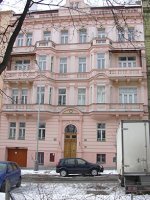As I said earlier in this thread, we really looked at ICFs but in the end, the money said to build with 2x6 walls with an R value of 25 or so. Since we wanted lots of big windows, it did not make money sense to build with ICFs, and then put big holes in the walls. Not sure it made sense to use 2x6x either.
Every major room has a 8'x6' window with the exception of the kitchen which has a 8'x5' window. The living room has an 8'x5' and a 12'x6'. There are a LOT of BIG holes in our walls.

The house is 2,425 sf with 10 foot ceilings.
I paid the power bill this week. I have tracked every power bill we have had since we built the house. We did this see if the design and construction worked from an energy, and thus money, perspective. It has. Our power costs our the same or less than our city house which was less than half the size of the current house.
We heat with wood so the only time the HVAC is used is during hot weather for AC or if we run out of firewood in the spring.

This makes it somewhat easy to figure out our HVAC cost.
The last bill period was mostly very hot and humid. Not spring but summer weather. The power bill was $135. Which happens to be the monthly average over the last couple years.
The first few months of 2011, with no HVAC, the power bill was around $115-120. Last December was worse since we were home, had visitors, and used the oven quite a bit. That bill was $150ish.
Our AC bill last month was maybe $15-20.
The worst cooling bill we had was $221 last summer when it was 100 degrees day after day. That was an unusual bill. We ran out of firewood one year and had to turn on the heat and the bill was about $175.

Go back to Beppington's numbers. Our worst case heating and cooling bills are $100 a month which does not happen often. The extra cost to use ICF's just does not make money sense from an energy usage perspective for our house. Beppington's numbers are also low since he was just looking at the loan cost and not what the money could have earned if invested.
If we live on the coast, and could get hit by the full force of a hurricane, then we would have built with ICFs. Not for energy but to be safer in a storm. :laughing:
There is a program called RESFEN developed by US government. I mentioned it earlier in this thread or the other home building thread that has been active recently. This program models your house based on the size and number of windows, their performance numbers, size of house, type of heating and cooling, energy costs, house location, etc. I used it to evaluate the windows we were looking to buy. The programs energy usage and cost for heating and cooling were pretty danged close to what we get in the house.
Later,
Dan

